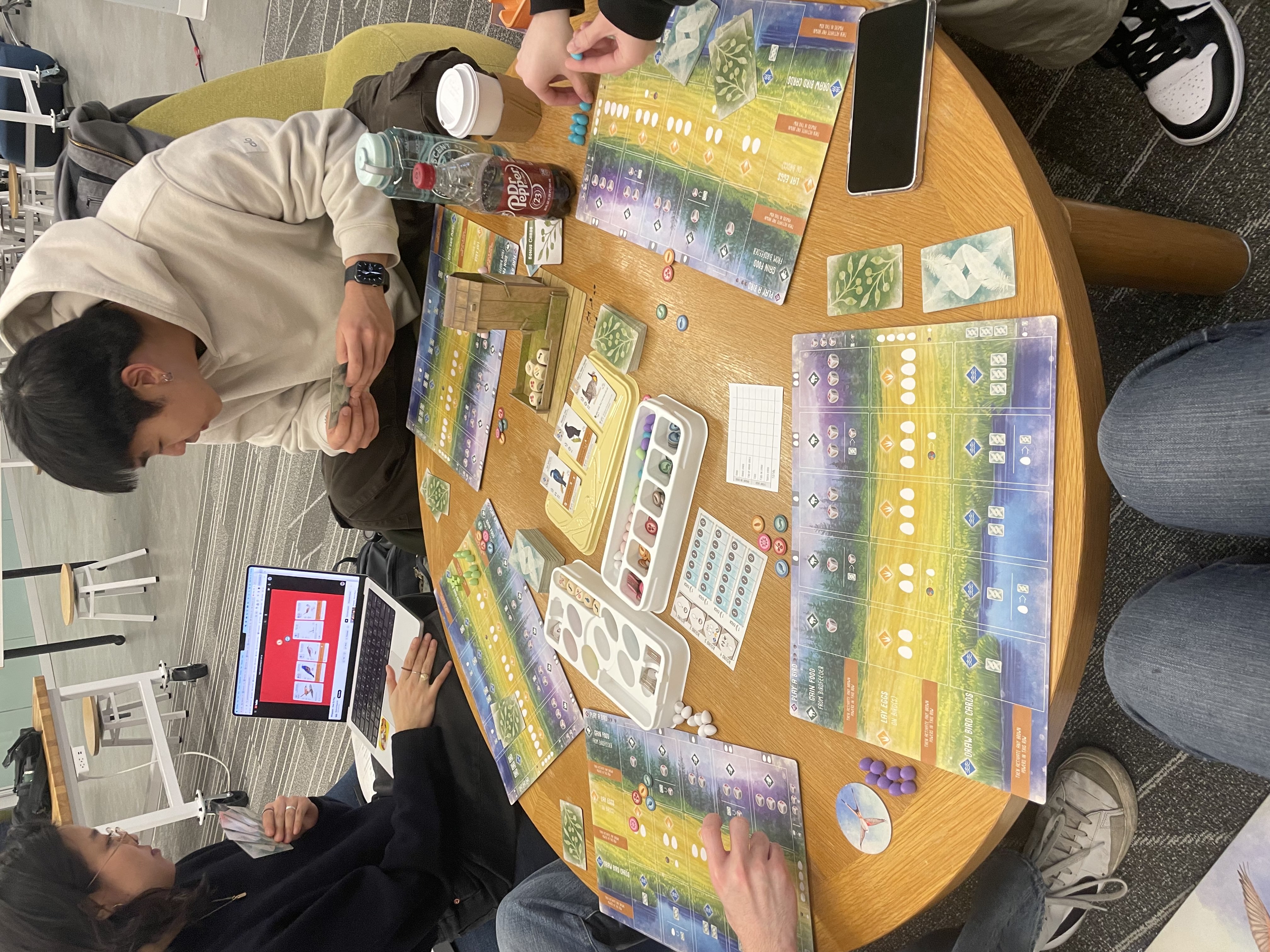Jason Frey, Erin Matthews, Ben Sim, Annaliese Vorhees, Steph Chung
One of the games that our group played this week was Wingspan. This is an engine-building game in which the goal is to create a diverse ecosystem of birds with compatible powers, flocks, hatching abilities, habitats, and food sources. In Wingspan, the visuals and materials are key to the play experience. Each player has game mats, action cubes, food tokens, bird cards, bonus cards, and eggs. Meanwhile, the table shares a group goals sheet, a point scoring sheet, a set of customized food token dice, decks of bird and bonus cards, a supply of food tokens and eggs, and a dice rolling tower. All of this is done in beautiful colors and extreme detail, with each bird card containing a representative image of the species with fun facts and food/habitat stats that correspond with the actual species’ living conditions.
This game was quite complex, especially on first play. After apportioning the correct materials to everyone (which took a full 20 minutes of learning and sorting), we proceeded in a turn-by-turn order, slowly at first, playing our actions and moving on. Each player is responsible for collecting the maximum number of points that they can by playing down cards in the correct habitats with valid spending tokens and building up other game pieces on their board. After 4 rounds, each of which consists of 8 turns per player, the game ends and points are tallied. While playing, each player must keep track of maximizing six different sources of points within their own materials, as well as 4 other group goals, which are also sources of points. This interplay among point sources makes for complicated strategizing and many ways to win.

Wingspan offers players opportunities to score points through both group and individual goals. Group goals serve as a communal competitive edge, where players vie to meet specific criteria by the end of each round, such as having the most eggs in a particular habitat or the greatest number of birds with a specific nest type. These goals can foster a sense of camaraderie but also ignite spirited competition, since players must balance their pursuit of these objectives without derailing their individual game plans. Individual goals, on the other hand, stem from bonus cards and personal strategies that guide players in forming their ecosystem of birds. These goals might encourage a player to focus on accumulating birds of a certain habitat or species, which adds a layer of personal achievement to the game’s broader objectives.
The four action types are the game’s backbone, as they each with the others to create a seamless gameplay experience. (1) Playing a bird involves placing a bird card onto your board. This move requires the expenditure of food tokens and potentially eggs, depending on the bird’s habitat. This action is foundational, as it enables players to populate their boards with birds that will generate points and other benefits. (2) Gaining food is executed through the birdfeeder dice tower, which determines the types of food available. This action is crucial for supporting further bird plays, which illustrates the game’s thematic emphasis on the interdependence of species. (3) Laying eggs adds eggs to birds, serving multiple purposes: they are a source of points, a currency for playing certain birds, and a requirement for meeting some group goals. (4) Finally, drawing bird cards offers players the chance to expand their options and adds new birds to their hand that can be played later for strategic advantage. Players may only take one action per turn, with eight turns per round.

These four types of actions interact with each other such that you, the bird enthusiast, try to create a full-fledged bird ecosystem. You can’t get away with stacking birds in one row. The game encourages players to have a diverse bird population, and doing so will end up rewarding the player with more points in the long run. In our play session, we found that those of us that had fewer birds yet had better synergy—characterized by powers, flock, and egg combinations that complemented each other—ended up garnering more points than those who just wanted to spread out as many birds as possible or min/max the number of birds within a row. Each bird doesn’t directly rely on another, but rather there are birds that provide better bonuses to the already existing birds than others, and as such these bonuses encourage the players to build an ecosystem where the birds benefit from each other. In this way, the game captures the diversity of an ecosystem and how each player’s system is different.
The game’s mechanics also give the player incentive to plan out their game strategy. Placing down birds requires you to feed them, and as such the player has to keep taking the food action to feed their birds. However, since the base food gathering rate is already so low, it incentivizes players to put down other birds to get more food and grow their bird sanctuaries, which then means that they need to have more eggs, which necessitates more egg actions. And only then, when the player is out of bird cards, do they have to take the bird action and collect more cards. Each action is heavily dependent another, and as such it is the player’s goal to create and collect the right birds to boost the rewards reaped by the actions. You start small, but overtime create an abundant and bountiful ecosystem of your own.
